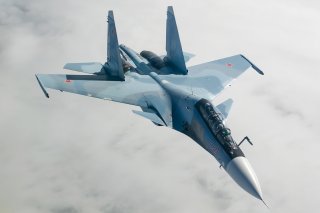Black Sea Showdown: Why Russia’s Military Reflexes Are Steadily Increasing
The Black Sea region has seen a steady escalation of Russia-NATO military tensions in recent months.
A Russian fighter was scrambled to intercept a U.S. spy plane over the Black Sea, according to the country’s National Defense Control Center. “A Su-30 fighter of the Southern Military District’s air defense quick reaction alert forces was scrambled to identify the aerial target and prevent it from violating the Russian state border," according to the center’s statement. “The crew of the Russian fighter identified the aerial target as a US Air Force EP-3E Aries electronic warfare and reconnaissance aircraft and shadowed it.”
The National Defense Control Center added that the EP-3E in question changed course before entering Russian borders. “After the foreign military plane made a U-turn from Russia’s state border, the Russian fighter safely returned to its home airfield,” the center noted. “The Russian fighter’s flight proceeded in strict compliance with the international rules of using the airspace.”
The Sukhoi Su-30 is a two-seat, multi-role fighter that is regularly used by Russia’s military for interception sorties. The fighter has seen widespread export success in the decades following its introduction, spawning numerous variants along the way. The Su-30MKI export version for India, jointly produced Sukhoi and local Indian manufacturers, notably featured thrust vectoring capabilities. The Royal Malaysian Air Force’s Su-30MKM features a slew of avionics upgrades as well as supermaneuverability, while China’s Su-30MKK was specialized for strike missions. Other Su-30 operators include Armenia, Angola, Indonesia, and Kazakhstan.
Russia’s military operates over one-hundred modernized fourth-generation Su-30SM fighter jets, featuring a new radar suite, additional electronic warfare capabilities, and expanded armament options. All currently-serving Su-30SM fighters are scheduled to be upgraded to the Su-30SM2 revision, which will reportedly offer the new Irbis-E radar and same AL-41F1S engines as the ones found on the Su-35 fighter jets.
The Black Sea region has seen a steady escalation of Russia-NATO military tensions in recent months. Less than one week ago, Russian Su-30s intercepted a U.S. Navy Boeing P-8 Poseidon that was allegedly flying towards Russia’s state border. Late last month, Russia’s Coast Guard and its Black Sea Fleet fired warning shots and dropped bombs to chase the British Type 45 Destroyer HMS Defender out of its claimed territorial waters off the Crimean coast. Russian President Vladimir Putin appeared to suggest in a later interview that Russia’s military could have sunk the HMS Defender without triggering a major war because, in his words, Western governments “know they could not win a war like that.”
Putin’s comments reflect what is the Kremlin’s increasingly uncompromising stance on NATO drills and innocent passage operations in Russia’s claimed territorial waters, particularly in and around Russian-occupied Crimea. The Seabreeze 2021 exercises, co-hosted in the Black Sea from June 28 to July 10 by the United States and Ukraine, prompted swift and vigorous condemnation from Moscow. Russia’s Foreign Ministry spokeswoman Maria Zakharova called the drills “provocative muscle flexing,” adding that "combat deployment of such a scale near Russian territory evokes a corresponding reaction from us.”
Mark Episkopos is a national security reporter for the National Interest.
Image: Wikimedia Commons

